Flexing Muscles Over Mussels
California’s Only Open-Ocean Shellfish Farmer Struggles to Grow His Santa Barbara Operation
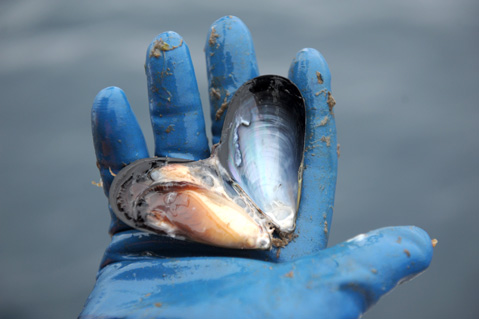
Bernard Friedman’s typical day starts around dawn, when the first rays of sunlight paint the Santa Ynez Mountains pink. As smells of hot coffee and diesel gas waft through the Santa Barbara Harbor, he hops onto his 35-foot boat Perseverance — so named for the 13 years he courted his wife, but a trait he’s forced to exhibit endlessly — and heads out to sea.
Unlike most Santa Barbara fishermen, from urchin divers to black cod long-liners, who must navigate for miles to reach unpredictable fishing grounds, it takes less than 15 minutes for Friedman to pull up to his sure-thing site, a 25-acre underwater grid of mesh ropes connected by red, blue, and green buoys located less than a mile off of Hendry’s Beach. A few minutes later, as the sunrise starts reflecting off the glass windows of The Boathouse restaurant, Friedman is already hauling in his morning catch, a few hundred pounds of mussels that he grew from tiny seeds to plump shells over the past year. They’re sheared off the clumpy ropes onto the spinning bristles of a specially designed scrubbing machine and will later be hand-washed on deck and dumped into the purple mesh bags that find their way to restaurants and seafood dealers hundreds of miles away.
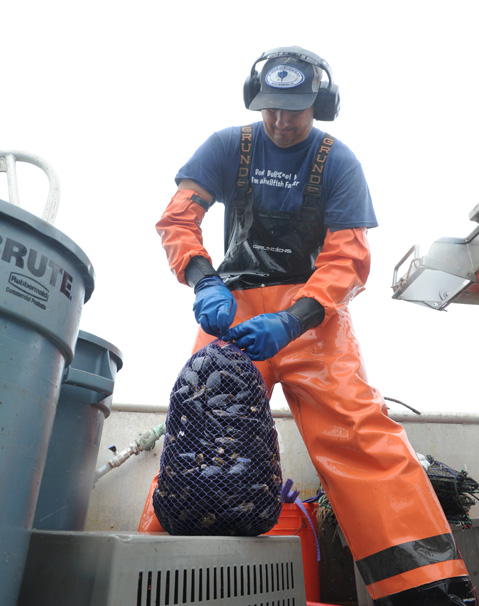
He’s repeated this routine most days of the past 12 years, yet the 2014 haul was the biggest yet: more than 160,000 pounds of mussels, and the first time he’d ever maxed out the farm’s current capacity. “I can’t grow enough mussels to satisfy the demand,” explains Friedman, who fields orders on his cell phone from the Santa Barbara Fish Market, Harbor Seafood, and Kanaloa Seafood while on the boat. “We harvest exactly what people need, and you can be eating it tonight. What we do is unparalleled in most farming industries. We harvest to order.”
Friedman’s job is even more unique than that. While a handful of shellfish farms exist in coastal estuaries and some freshwater fish species are cultivated on land, the 42-year-old is the only open-ocean aquaculturist in the entire state of California. He founded Santa Barbara Mariculture in 2002 by taking over an existing but essentially forgotten offshore oyster farm. He eventually moved to mussels, and business blossomed, fertilized by modern culture’s insatiable desire for locally grown, sustainably sourced cuisine. Friedman believes he could easily double his business and move 7,000 pounds a week, which wind up on plates from the Central Coast south to San Diego and out to Arizona. “Just this town alone could exceed 2,000 pounds a week,” he predicted.
And it’s not just hungry foodies banging the drum. As the world watches wild-caught fish stocks disappear, today’s aquaculture advocates — including prominent UCSB scientists, who can see the Perseverance working from their oceanfront offices — believe that fish farms, when done right, are critical to feeding the Earth’s exploding population. Shellfish, in particular, give the most protein bang for the buck with the least environmental impacts. And most everyone agrees that it’s high time the United States — which chalks up more than $11 billion in annual trade deficit by importing 91 percent of our seafood, half of that from often under-regulated fish farms — started putting more oars in the water.
Yet even with the stars so magically aligned, and a banner year under his belt, Friedman fears his business may not be able to grow or even survive. Though he’d held a 72-acre lease from the California Department of Fish and Wildlife for a decade and always farmed about 25 acres, Friedman learned in 2012 that he was really only permitted by the state to farm one acre. Let’s fix that, he thought, only to quickly learn that his graduate degree in fisheries management did not prepare him for the costly, time-consuming regulatory rigmarole he’d have to endure, especially if he wanted to expand the farm to harvest more mussels and maybe even oysters or scallops. But three years, multiple studies, and lots of correspondence later, the alphabet soup of agencies involved still can’t predict when or if he’ll ever be legal.
In the meantime, two ambitious open-ocean fish farms are swimming into Southern California waters. Both are state-of-the-art attempts to tackle America’s seafood deficit on a grand scale, and that could be good for the gander. But both are backed by millions of investment dollars and robust research initiatives, putting Friedman’s mom-and-pop-sized golden egg in jeopardy. He fears that the onerous, expensive rules established for these large operations will keep artisanal fish farms like his out of the game for good.
“Sometimes I get the feeling that I was never supposed to actually make it, that open-ocean farming is for the millionaires, not for the small guy at all,” Friedman told me one sunny morning last month, as bivalves flew across the bristles and into trash cans full of sea water. “But somehow I’ve succeeded — at least for the moment.”
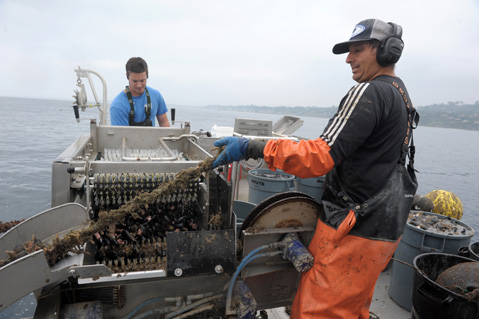
Fish-Farm Fun
Aquaculture goes back to the earliest days of California statehood. After the San Francisco Bay’s native oysters were decimated by ’49ers during the Gold Rush, the state began importing oyster seed from Washington State and Mexico. Commercial oysters really took off in 1875, when East Coast species were one of the first products delivered to town on the transcontinental railroad.
Today, the state’s shellfish farms are mostly in Humboldt, Tomales, and Morro bays; Drakes Estero was also a hub for oysters until the National Park Service ended that operation last year amid much controversy. There are also a few abalone farms (including The Cultured Abalone on the Gaviota Coast); many more freshwater trout, bass, tilapia, and catfish farms; and the country’s largest caviar industry thanks to the white sturgeon farms of the Sacramento Delta.
Open-ocean aquaculture, meanwhile, is quite popular across the globe, and a limited amount exists in other parts of the United States, particularly the Northeast. But it remains elusive in California, where it’s daunting on many levels: Anchored farms may not withstand our wave-wracked coastline; the on-deck work is much harder, costlier, and riskier than toiling in tranquil tidal flats; and, most prohibitively, very few have the wits, wherewithal, or wallet size to carve through the state’s strong coastal-protection policies.
Friedman wouldn’t have a farm if it weren’t for Jeff Young. The Los Angeles native and UCLA alum created the original lease in the early 1980s while finishing his graduate degree in fisheries at Humboldt State, where he saw oysters grown in Humboldt Bay. When his then-girlfriend (now wife) promised to move back from Hawai‘i if they could live in Santa Barbara, he realized that, unlike the rest of California, the coastline lies west-to-east and is further protected from the rough Pacific by the Channel Islands. Young thought a shellfish farm might work here.
And it did, but there was another problem: Young’s oysters made people sick, thanks to the poopy water that wastewater treatment plants were pumping into the ocean. So Young got a crash course in water-quality law and fought a multiyear battle against the Goleta Sanitary District and City of Santa Barbara, eventually reaching a confidential settlement. “That’s ultimately how I became a lawyer,” said Young, who now handles civil litigation and copyright cases from his office next to the Arlington Theatre and also sits on the Regional Water Quality Control Board. He worked the farm without much success until the mid-1990s and then didn’t think about it for years.
While Young was laying the original anchors, Friedman was still a high school student in Palm Beach Gardens, Florida. The son of a dentist and homemaker, Friedman always loved growing things and even served as president of his school’s Future Farmers of America chapter. He came to surf Los Angeles at age 19, wound up taking biology classes at Santa Barbara City College, and then got a degree in biology from UC Santa Cruz. On research diving projects in Alaska and later for UCSB, he was mentored by some of the more esteemed marine ecologists in history, like otter expert Jim Estes and rockfish guru Milton Love.
In 1998, Friedman started working for Ecomar, the innovative company that scraped mussels off of Santa Barbara Channel oil rigs and sold them commercially. He returned to academia a year later, heading to the University College Cork in Ireland for a master’s in fisheries management, development, and conservation. “I ditched everything, put all I had in two suitcases, and left the country,” he recalled. “I didn’t think I was coming back.”
But longtime girlfriend Rebecca Frodsham, whom he eventually married in 2006, lured him back to Santa Barbara for the summer of 2000, where he wound up at Ecomar as a diving supervisor. “Bob Meek taught me a lot, how to be a businessperson, how to make money on the ocean,” he said of Ecomar’s owner, who died suddenly while diving in 2004. “It’s really easy to go bankrupt out here. You need to design for failure and be ready for the ocean to kick your ass.”
As part of his graduate thesis, Friedman tested how oyster seeds performed on an oil platform off of Carpinteria. When they worked, he contacted Young about taking over his old, unused lease in 2002. “I don’t know if I ever charged him anything,” said Young. “I was just thrilled that someone would make use out of it. I think it’s a great resource that’s benign to the environment.”
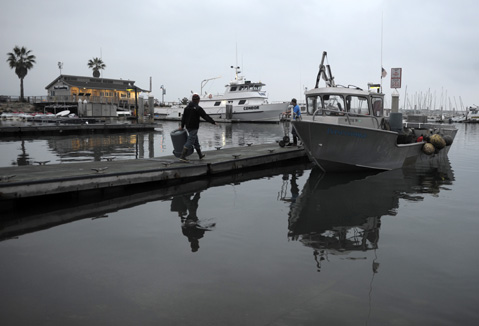
Rise of Localism
Santa Barbara Mariculture was born in an opportune era, right as vast swaths of the population started buying locally grown foods for both environmental and nutritional reasons. Friedman’s “Hope Ranch Oysters” were incredibly popular for a while, but he decided to focus on mussels alone in 2010 when domoic acid poisoning wiped out his oyster crop. Aside from some other ups and downs, like when scoter ducks decimated his mussel seed in 2008 and caused him to default on his boat loan, Friedman’s business steadily grew.
Such growth came despite lingering public perceptions that fish farms are not so groovy. Indeed, shrimp farms do decimate mangrove forests, nonnative fish have infiltrated wild populations, and antibiotics, vaccines, and food coloring used in crowded fish pens freak people out. Plus, the early promise of fish farms was undercut by how many wild-caught fish were required to grow popular species like salmon, which once required five pounds of feed to get one pound of protein out.
Shellfish farmers avoid most of these problems, particularly because their crop feeds on free-floating phytoplankton. But technology is also tackling most other fish-farm concerns — at least in countries that care about ecological impacts. More efficient fish feed now exists, and sustainable practices are more tracked than ever thanks to tools like the Monterey Bay Aquarium’s Seafood Watch, annual reports from the United Nations’ Food and Agriculture Organization and the World Resources Institute, and certification programs that big guns like Walmart rely on.
That’s a good thing, says Hunter Lenihan, director of the Sustainable Aquaculture Research Center at UCSB’s Bren School of Environmental Science & Management, who said half of the planet’s seafood demand is already being met by aquaculture. “We have maxed out wild fisheries, but we still have a growing human population with a growing seafood demand,” said the Berkeley-raised marine ecologist who’s been at UCSB since 2002. “The only way we’re going to feed people with a healthy protein from the ocean is aquaculture.”
With many of the legitimate impacts being handled, Lenihan believes people will start to look more kindly on fish farms, especially thanks to good examples like Santa Barbara Mariculture. “We’re on the cusp,” he said. “Society is increasingly understanding the impacts of wild-caught fisheries on ocean ecosystems. Aquaculture is an exploding field for the rest of the world, but in the United States, there’s been relatively slow growth. I think we’re going to see a big change.”
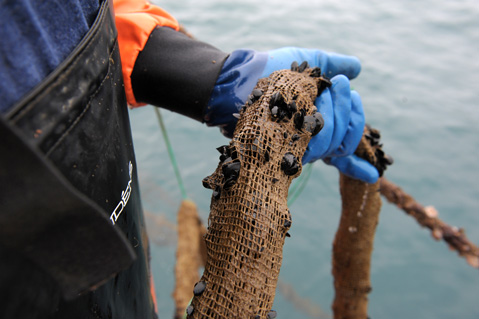
Radar Blips and Spider’s Web
Phil Cruver drank that same Kool-Aid about five years ago. That’s when the venture capitalist/entrepreneur, who’s led six tech start-ups so far, asked Friedman how mussel farming was done. After hearing the secrets, Cruver began assembling investors to fund what was originally going to be a 1,076-acre farm about eight miles off of Long Beach. In October 2011, he submitted an application to the Army Corps of Engineers, which granted permits four months later, and then applied in July 2012 to the Coastal Commission, which evaluates marine impacts even for projects in federal waters. (State waters extend to three miles.)
That application landed in the San Francisco office of the Coastal Commission’s aquaculture specialist Cassidy Teufel, who did a double-take on references to Santa Barbara Mariculture. “I thought I had a pretty good sense of what was out there,” said Teufel, who’s worked on aquaculture for a decade, “but that was the first time I had ever heard of it. I was pretty surprised. I wasn’t aware that there was any open-ocean farming.”
Teufel inquired with Friedman about his permits, and it became apparent that Santa Barbara Mariculture was lacking more than the Coastal Commission’s sign-off; in fact, the 25-acre farm was only permitted for one acre, and it was in the wrong place. Friedman was shocked, believing that his Department of Fish and Wildlife lease and the old permits were all he needed. “It’s like paying a landlord and then the building inspector comes in and says, ‘You can’t live here,’ ” explained Friedman.
Luckily, no one wanted to kick him out. “Our preferred approach is to work with the operator to get them under compliance,” said Teufel. “If they are making a good-faith effort to do that and making progress, we just continue along that route.”
With Pandora’s permitting box open, and his Department of Fish and Wildlife lease needing renewal anyway, Friedman decided he might as well get approval to reorient the farm and expand beyond the 25 acres he works into the 72 acres he rents. That took him back to square one of the permitting process, so he’s in the midst of an exhaustive California Environmental Quality Act, or CEQA, study. Once that’s complete, he’ll need signatures from the following: the California Fish and Game Commission (for the lease); the Army Corps of Engineers (which consults with the National Marine Fisheries Service on underwater structures); the Regional Water Quality Control Board (for impacts to water quality); and the Coastal Commission (for impacts to marine life). His existing seafood-safety permits from the state Department of Public Health and the federal Food and Drug Administration remain valid.
Most concerning is the Coastal Commission, and not just because Teufel translates to “the devil” in German, the native tongue of Friedman’s mother. As anyone who’s pursued anything on the California shoreline will attest, the Coastal Commission’s purview is notoriously broad and rigorous. In Friedman’s case, Teufel will evaluate the “likelihood and magnitude” of such impacts as marine mammal entanglement, hazardous spills of oil or gas from the boat, changes to the underwater habitat and water quality due to shell or other debris, reduction in phytoplankton due to the feeding mussels, and the introduction of parasites, disease, and nonnative species, as the mussel of choice is from the Mediterranean Sea.
With a background in marine ecology, Friedman appreciates the questions but is frustrated that his 12 years of work with no known impacts isn’t enough common-sense evidence. He’s already had to prove that he works on a sandy bottom, which is barren compared to a reef-based seafloor, so debris impacts should be negligible. He routinely sees dolphins and sea lions use his farm as a nursery and bedroom, rather than it being some danger zone, explaining, “There’s no farm on the planet that lets large mammals go through it. There’s nothing like this!” And he’d prefer that his Mediterranean mussels — which he says clean up the ocean as filter feeders and act as sentinels of water quality — should be considered a “naturalized” species since they’ve been in California waters for 150 years. “Who farms native food? Nobody!” he declared. “No one ever says, ‘Would you like a glass of nonnative chardonnay? Would you like some nonnative chicken?’”
Friedman’s beliefs are backed up in part by 15-plus years of East Coast aquaculture. University of New Hampshire research professor Richard Langan started fine-tuning open-ocean mussel farming in 1998, and there’s never been a whale entanglement or other major marine impact. “Nothing’s happened in all the years we’ve had mussel lines out in the water,” he said. “Everything is going well. The environmental concerns are really nonissues here.”
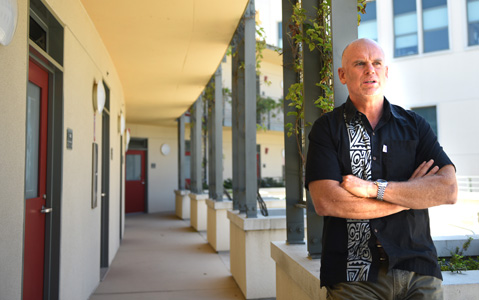
Accept, Adapt, Collaborate
Hunter Lenihan of the Bren School, who once worked for the National Marine Fisheries Service, wants aquaculture’s potential impacts to be examined with potential benefits in mind. “There is no free lunch,” he told me over the phone after returning from a morning tour on the Perseverance. “If humans are going to eat, there are going to be some impacts.”
He also hopes the oversight will be adaptive, as the real concerns aren’t yet known. “We should all be moving forward together in a collaboration to identify the risks, to test for them, and to assess the real scientific costs and benefits,” said Lenihan, who pledged to throw the Bren School’s considerable weight behind Friedman’s case. “Perhaps aquaculture is a way we can think about streamlining the whole process for the benefit of the environment and everyone else.”
In fact, the government’s many aquaculture-focused agencies are already moving in that direction. More than a year ago, the California Shellfish Initiative was launched to get all the regulators at the same table and determine a way to make the permitting process less scary. “The problem is that the regulations were all laid down piecemeal and for different reasons,” said the California Department of Fish and Wildlife’s Randy Lovell, who is leading the initiative. “Nobody was thinking about the impacts to aquaculture.” The group will soon meet in Sacramento for the fifth time, and Lovell hopes to one day offer a “virtual application desk” online that will guide hopeful fish farmers through the process.
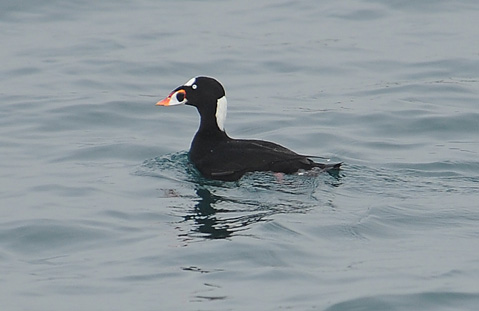
Innovation is also happening in the Humboldt Bay, where the regional harbor district is taking the lead in acquiring permits for small oyster farms, which they plan to sublease to individual fishermen. Regulators like the approach because it considers the entire ecosystem, and fishermen can jump right into farming rather than spend years and savings accounts on permitting. Much closer to home, UCSB’s Bren School recently examined the Santa Barbara Channel and produced a map that identified areas suitable for fish farms when all other uses, from shipping lanes to no-fishing zones to popular fishing grounds, were factored in.
These efforts aren’t doing Friedman much service yet, but pioneers should never expect the easy road. “The first guy through the permitting gate is always going to have the highest bar to meet,” said Diane Windham of the National Marine Fisheries Service. “Are we asking the right questions? Is it being measured correctly? With something that’s never been done before, that analysis is harder to do.”
But the regulators are pulling for him, and the Coastal Commission’s Teufel has been open to creative, cost-effective research that won’t put him out of business. “There are a lot of people who don’t want to see the process chew up and spit out someone like Bernard,” said Lovell of Fish and Wildlife, who thinks others, especially existing fishermen seeking a second income stream, will copy Friedman if he succeeds. “He’s a good citizen, and he’s admired and respected by people in the community.”

Grand Scale, Good and Bad
Though Friedman is still the only working open-ocean fish farmer in California, he’s no longer the only one allowed to do so. After nearly three years, hundreds of thousands of dollars in direct and indirect costs, a change in location, and a drastic reduction in size, Phil Cruver successfully won permits for his Southern California project. Now called the Catalina Sea Ranch, his 100-acre farm is located six miles off of Huntington Beach in 150 feet of water, where he hopes to harvest 2.7 million pounds of mussels annually, starting toward the end of the year. He’s attracted $1 million in investments so far while actively raising another $3 million, and is now hoping to spin off a subsidiary marine research firm called Marine Big Data, since developing one was the smartest way to satisfy the government’s environmental-monitoring demands.
Though supportive at first, Friedman now realizes that his wisdom may have been used by Cruver to carve a permitting path so expensive and monitoring program so onerous that everyday fishermen will be cut out. “It’s going to cost $1 million to make $1 million,” said Friedman. “It doesn’t make any sense.”
A true businessman, Cruver hopes the big barriers to entry will deter competitors. “We’ve got a good lead on this,” said Cruver, who’s also seeking eight patents and plans to give investors good returns for the next 20-plus years or, if things really go well, sell the company for bigger money. “It won’t work as an artisanal thing,” he admitted. “Bernard is a one-man show, but to do it on a massive scale, you can’t do it for less than $3 million.”
On a similarly grand scale yet focused on yellowtail and sea bass, Rose Canyon Fisheries applied last October to build a seven-acre farm capable of producing 10 million fish per year in pens about five miles off of San Diego. The project is a joint venture between Hubbs-Sea World Research Institute and the venture capital, aquaculture-focused firm Cuna del Mar, whose Canadian managing partner, Robert Orr, made his fortune on fish oil. Permitting is expected to take up to 18 months, and then it will be another two years for the first fish to be harvested, long after millions have been spent.
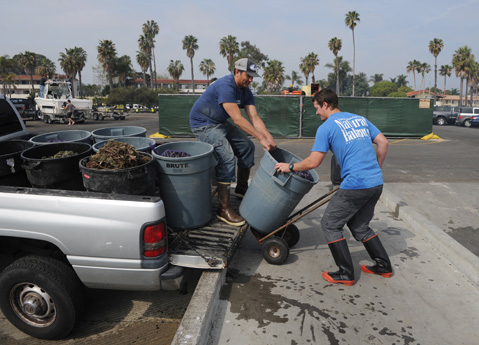
Hope for Hope Ranch Mussels
From his statewide vantage point in San Francisco, the Coastal Commission’s Cassidy Teufel is not yet convinced that aquaculture is going to save the world. “That very well may be, but I think a lot of that remains unsettled,” explained Teufel, who believes the mission of his agency is to “ensure that those activities that may be good for us are carried out in a manner that is good for us.” He trusts Friedman hasn’t harmed a soul but countered, “Just because something hasn’t gone wrong yet doesn’t mean it won’t in the future. … He wants to be doing the right thing, and he could be thinking of everything and doing everything possible, but we’ve got to double-check that.”
But even this most critical of regulators is optimistic that Friedman will still be farming mussels in the future. “I feel confident that he will,” said Teufel. “There are some things that need to be looked at closely to ensure there are no adverse impacts, but from what I know now, it’s looking pretty good for him.”
Friedman, meanwhile, just wants clarity so he can move on with his life, which otherwise surrounds his wife and two kids at his Noleta home. “I want to be legitimate,” he said. “Let’s do this for real. If you don’t want me to grow, I’ll do something else. But I think people really like my mussels.”



